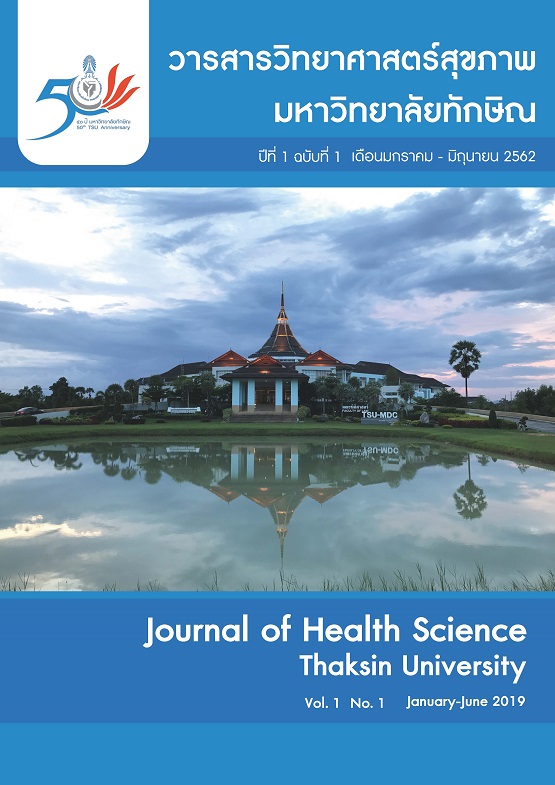Comparison of Temperature Measured by Axillary Digital Thermometer and Forehead Infrared Sensor Thermometer
Main Article Content
Abstract
A cross-sectional analytic research aimed to compare the temperature measured by axillary digital and forehead Infrared sensor thermometer. Of these, 210 samples who were patients accessed to the service at Klonghoikong Hospital of Songkhla. The data was collected and recorded using axillary digital and
forehead infrared sensor thermometer from February 1st, 2019 and March 31st, 2019. Each subject was measured body temperature by axillary digital and front forehead infrared thermometer. Paired t-test, Bland-Altman and ROC curve were used in this study. Results showed that the axillary temperature (T=37.58 °C)
had higher mean value than the forehead (T= 37.45 °C). The mean difference ( X =2.43; p-value = 0.010). The axillary temperature and the forehead were significantly different (Mean difference = 0.13, 95%CI = 0.02, 0.24, p-value= 0.01). The 95% limits of agreement was 3.09. The cut point of predicting axillary temperatures at 39.05 °c. Area under the receiver operating characteristic (ROC) curves was 78.80%, 50% of sensitivity, 88.90% of specificity, 52.93% of positive predictive value, 48.34% of negative predictive value. It was accurate that forehead cut points at 38.75 °C. The area under the receiver operating characteristic (ROC) curves was 57.00%, 0% of sensitivity, 88.90% of specificity, 0% of positive predictive value, and 0.50% of negative predictive value. The axillary digital thermometer had higher different, inconsistent and more accurate than forehead infrared thermometer. Therefore, using infrared temperature sensor forehead could not be used as a substitute for axillary digital temperature in clinical practice among general out-patients.
Article Details
References
2. Bridges, E., Thomas, K. Noninvasive measurement of body temperature in critically ill patients. Crit Care Nurse. 2009; 29(3): 94-97. (in Thai)
3. Marable K, Shaffer LE, Dizon V,Opalek JM. Temporal artery scanning falls short as a secondary, noninvasive
thermometry method for trauma patients. J Trauma Nurs. 2010; 16(1): 41-47. (in Thai)
4. Tangpanitandee, S., Thongcher, V., Jaritkuan, O. Accuracy and Precision of Non Invasive Temperature Measurement in Febrile and Non-Febrile Volunteer at Outpatient Department. Journal of Nursing Council. 2015; 33:
103-113. (in Thai)
5. Sangson, N. Assessment of Newborn’s Temperature by Glass and Digital Thermometer. Journal of the Royal Thai Army Medical. 2013; 66: 17-23. (in Thai) 6. Chiappini, E., Sollai, S., Longhi, R., Morandini, L., Laghi, A., Osio, CE. Performance of non-contact Infrared Thermometer for Detecting Febrile Children in Hospital and Ambulatory Settings. J Clin Nurs. 2011; 20 (May): 1311-1318. (in Thai)
7. Sethi, A., Patel, D., Nimbalkar, A., Phatak, A., Nimbalkar, S. Comparison of forehead infrared thermometry with axillary digital thermometry in neonates. Indian Pediatr. 2013; 50(12): 1153-1154. (in Thai)
8. Sener, S., Karcioglu, O., Eken, C., Yaylaci, S., Ozsarac, M. Agreement between axillary, tympanic, and mid-forehead body temperature measurements in adult emergency department patients. Eur J Emerg Med. 2012; 19(4): 252-256.
(in Thai)
9. Fortuna, EL., Carney, MM., Macy, M., Stanley, RM., Younger, JG., Bradin, SA. Accuracy of non-contact infrared thermometry versus rectal thermometry in young children evaluated in the emergency department for fever. J Emerg Nurs. 2010; 36(2):101-104. (in Thai)
10. Charoensatsiri, R. Accuracy of Infrared Forehead Skin Thermometer in Cutely Ill Children at Out-Patient
Department. Journal of Prapokklao Hospital Clinical Medicine Educat Center. 2014; 31: 43-51. (in Thai)
11. Senadisai, S., Arpanantikul, M. Handbook of Nursing Practicum Manual. Bangkok: Judthong Company, 2009.
(In Thai)
12. Lu, MJ., Zhong, WH., Liu, YX., Miao, HZ., Li, YC., Ji, MH. Sample size for assessing agreement between two methods of measurement by Bland-Altman method. The International Journal of Biostatistics. 2016; 12: 8. (in Thai)
13. Bland, JM., Alman, DG. Statistical methods for assessing agreement between two methods of clinical measurement. Intrnational Journal of Nursing Studies. 2010; 26. (in Thai)
14. Park, YJ. PS. Systematic Review and Meta-Analyses of Diagnostic Accuracy of Infrared Thermometer when Identifying Fever in Children.Journal of Korean Medical Science Acad Nurs. 2013; 43: 746-759. (in Thai)
15. E.C. Performance of Non-Contact Infrared Thermometer for Detedting Febrile Children in Hospital and
Ambulatory Settings. Journal of Clinical Medicine Nurs. 2011; 20: 1-8.
16. Salauayporn, U. A comparison of temperature measurement by traditional axillary technique with measurement by an aural infrared thermometer on children of a pediatric out department in a hospital of the central region of Thailand.
Chainat Boromarajonani College of Nursing, 2011.


